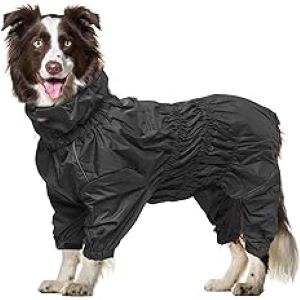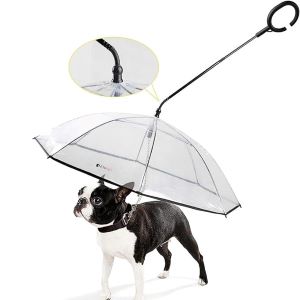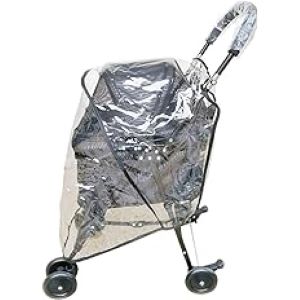Rainy days can be the best to enjoy with your furry companion. It can be cosy and fun for some dogs, but unpleasant for others. We often catch cold due to the rainy 🌧 weather, but is it the same for our Fido? If you are wondering whether dogs 🐶 get cold in the rain, the answer is not a piece of cake.
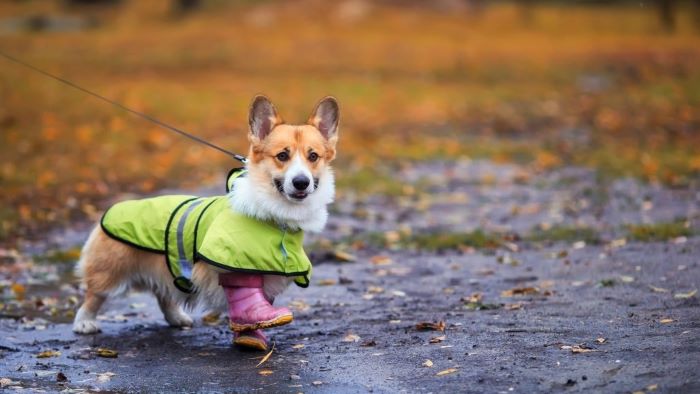
It depends on several factors such as the breed, size, coat, age, health and activity level of your dog. Let us explore how rain ☔ affects your dog’s body temperature and how to tell if your dog 🐕 is feeling cold in the rain.
You Might Also Like:
How Does Rain Affect Your Dog’s Body Temperature?
Dogs often have a higher body temperature than humans, between 38. 3°C and 39. 2°C. Dogs, unlike humans, do not, have sweat glands all over their bodies. Only the paw pads and their noses contain sweat glands, which are not very useful for cooling off.[1] Dogs’ body temperature is instead controlled by panting and evaporation from their tongue and mouth.
When it rains, the air temperature drops and the humidity increases. This makes it hard for dogs to cool down by panting and evaporation. Moreover, rain ☔ wets your dog’s fur and skin, which can reduce their insulation and make them lose heat faster. This can cause your dog’s body temperature to drop below the normal range, leading to hypothermia.
“Exposure to cold temperatures 🌡 is the most obvious cause of hypothermia in dogs, particularly if it’s also windy or the dog becomes damp“, confirms Jennifer Coates at PetMD. Hypothermia can harm your dog’s key organs and bodily processes and can even lead to death. Because of this, it’s crucial to keep your dog 🐶 from becoming too cold in the rain.
Do Dogs Get Cold in the Rain?
Answering — Do dogs get cold 🥶 in the rain is not that simple. It depends on various factors. Some dogs are more prone to getting cold in the rain ☔ than others. For example, small or skinny dogs, dogs with short or thin coats and puppies or senior dogs are more likely to feel cold in the rain.
Apart from this, dogs 🐶 with health issues and those who are not used to cold weather can also get cold in the rain. However, every dog is different and may react differently to rain 🌧 and cold 🥶.
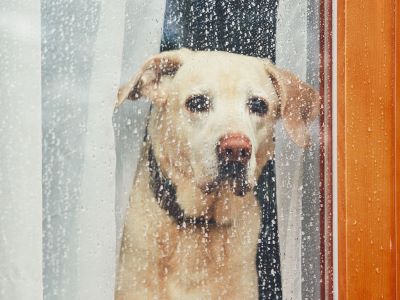
For instance, if your long-haired dog 🐕 goes outside after rain and his belly rubs the wet grass, he’s likely to get matted between his legs or belly, making it hard for them to retain body heat. Therefore, you should pay attention to your dog’s behaviour and body language to tell if they are feeling cold in the rain.
Some common signs that your dog is feeling cold in the rain ☔ are:
- Shivering or trembling
- Curling up or tucking their tail
- Seeking shelter or warmth
- Whining or barking
- Refusing to walk or move
- Showing signs of pain or discomfort
- Having pale blue gums or tongue
If you notice any of these signs in your dog, you should take them indoors as soon as possible and warm them up with blankets or a heating pad. Check for their body temperature 🌡, if it is below 37°C, you should contact your veterinarian 👩⚕️ immediately.[2]
How to Make Your Dog Enjoy Walking in the Rain?
Some dogs may not like walking in the rain 🌧 because they are afraid of the noise, the wetness or the cold. Is your dog one of them? Don’t worry! You can help your dog 🐶 overcome their fear and enjoy walking in the rain.
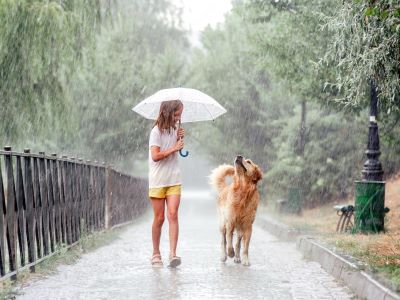
Here are some steps you can follow to make your dog enjoy walking in the rain:
- Start slowly: You can start by exposing your dog to rain gradually by using a spray bottle to wet your dog lightly. You can also play with your dog 🐶 in the rain and make it fun for them.
- Be positive: You can use a cheerful and confident tone to encourage your dog to walk in the rain. You can also smile and act happy to show your dog that rain ☔ is not scary or bad. You should avoid scolding or forcing your dog to walk in the rain.
- Be consistent: You can practice walking your dog in the rain regularly and consistently. This can help your dog get more comfortable with it. You should also maintain the same routine and rules for walking your dog 🐕 in the rain as you do in normal weather.
- Be flexible: You can adjust your expectations and plans according to your dog’s mood and behaviour. You can shorten or lengthen your walk depending on how your dog reacts to rain.
You can also invest in a dog umbrella hat to keep your dog’s head and back dry. The dog umbrella hat is attached to your dog’s collar or harness and provides overhead coverage as you walk.
Walking in the rain 🌧 can be a challenge for some dogs, but it can also be an opportunity for bonding and adventure. By following these tips, you can keep your dog 🐶 warm and dry in rainy weather and make them enjoy walking in the rain.
Tips to Keep Your Dog Warm and Dry
The best way to keep your dog warm and dry in rainy weather is to avoid going out when it rains. However, this may not always be possible or practical. Sometimes you may need to take your dog out for a walk or a potty break in the rain.
Here are some tips to keep your dog warm and dry in rainy ☔ weather:
- Avoid going out in the rain if possible, or limit the time outside to a few minutes.
- Provide your dog with a waterproof coat or jacket that covers their chest and belly. Also this leads to the question, do dogs need coats in the rain?
- Dry your dog thoroughly with a towel or a hairdryer after they get wet.
- Offer your dog a warm blanket or bed to curl up in after they come inside.
- Check your dog’s ears, paws, and tail for signs of frostbite, which is when the skin tissue freezes and dies.
It is important that you keep your dog dry and warm on rainy days. Observe for signs and symptoms, if his temperature 🌡 drops or shows any signs of cold, consult your vet 👩⚕️ immediately.[3]
FAQs
How can I tell if my dog has hypothermia?
Hypothermia is a condition where your dog’s body temperature drops below the normal range. It can cause symptoms such as shivering, lethargy, weakness, confusion, slow breathing, slow heart rate, low blood pressure, and even death. If their temperature is below 37°C, you should contact your veterinarian immediately.
What are some breeds that are more resistant to cold and rain?
Some breeds that are more resistant to cold and rain are those that have thick or double coats and large or muscular bodies. For example, some of these breeds are Huskies, Malamutes, Newfoundlands, Bernese Mountain Dogs, Saint Bernards and Tibetan Mastiffs. However, even these breeds can get cold in the rain if they are not properly cared for.
What are some breeds that are more sensitive to cold and rain?
Some breeds that are more sensitive to cold and rain are those that have short or thin coats, small or skinny bodies or are not used to cold weather. For example Chihuahuas, Greyhounds, Dachshunds, Poodles, Shih Tzus and Yorkies. These breeds may need extra protection and care when walking in the rain.
How often should I walk my dog in the rain?
The frequency and duration of walking your dog in the rain depends on your dog’s needs and preferences. Some dogs may enjoy walking in the rain and benefit from the exercise and stimulation. Other dogs may dislike walking in the rain and prefer to stay indoors. You should observe your dog’s behaviour and body language to determine how often and how long you should walk your dog in the rain.
Final Thought
Rainy days can be a challenge for some dogs, but they can also be an opportunity for bonding and adventure. By understanding the signs of getting cold and how to keep your dog 🐶 warm in rainy weather, you can make walking in the rain a safe and enjoyable experience for both of you.
You can also help your dog overcome their fear and enjoy walking in the rain with some training and patience. Remember to always monitor your dog’s condition and comfort level when walking in the rain and consult your veterinarian. 🌧🐶
If you’re wondering why won’t my dog go out in the rain, be patient and try the techniques in this article to help them overcome their dislike of rainy weather
References:
- Why don’t dogs sweat? (2013, October 9). Science Questions With Surprising Answers. Texas A&M University.
- Boldan, M., DVM. (2023). How to Take a Dog’s Temperature. PetMD.
- Dashing Through the Snow: Signs of Hypothermia In Pets. (2022, March 11). VMBS News.
